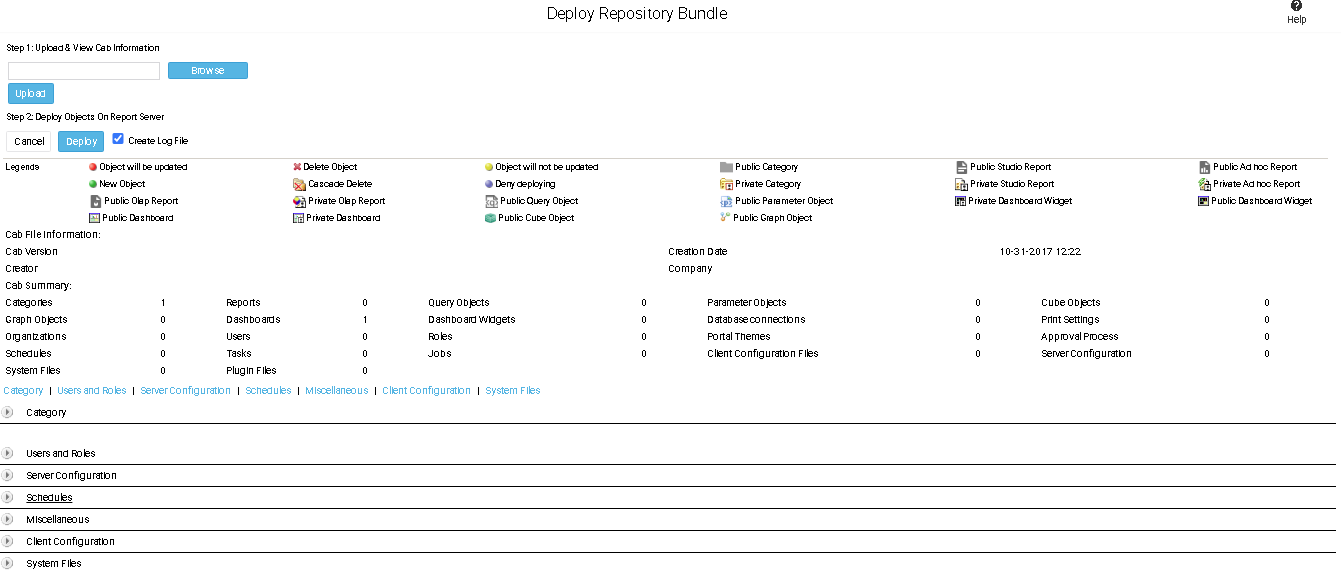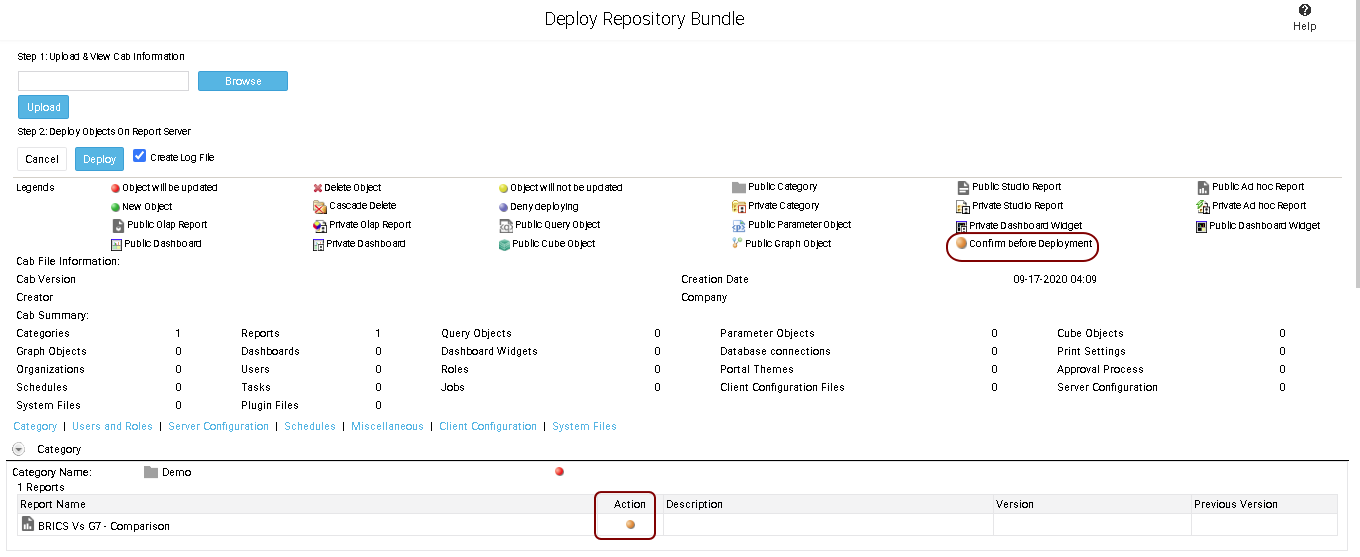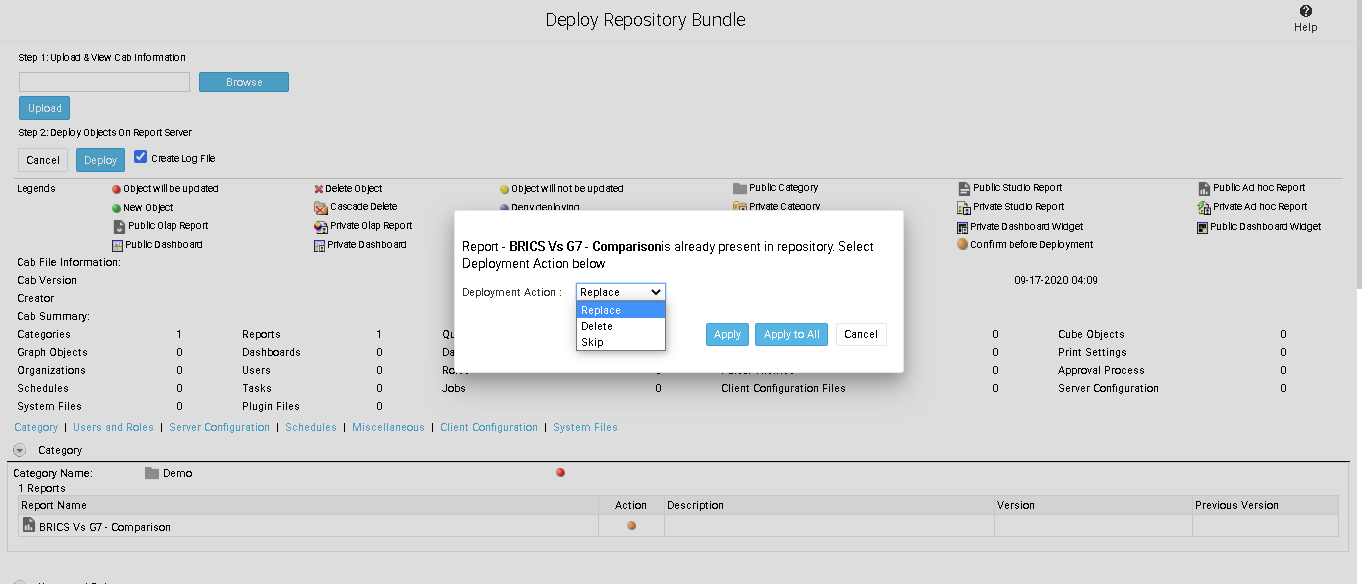Deploying the repository bundle on report server
Intellicus allows you to deploy the repository bundle objects on report server when you are upgrading application version or migrating from one server to another. Intellicus’ iPackager extracts references of the selected information (repository objects/users preferences/configuration settings) from the repository or file system and stores as .conf file (saved on the Web Server with a default name ‘Untitled.conf’). You can open a configuration file and make changes to it. A configuration file is then used to build the cab file. This cab file is later deployed on the Intellicus server.
You can deploy the repository bundle (cab file) to your report server so that the server can access the required bundle after your application is deployed.
This page discusses the steps to deploy the repository bundle to the server.
Note: A repository bundle is also referred as ‘Package’, ‘Bundle’ or ‘CAB’.
A cab file may have any of the following:
Repository objects like categories, reports, query objects, parameter objects, analytical objects, dashboards and dashboard widgets
Approval process details
Report Schedules
Organization, user, user access rights and user mappings
User created private objects
User/Organization preferences
Data connection information (along with access rights information)
Printer settings
Web client properties
Report Server configuration files
License File
Templates
To upload and deploy customizations in a repository bundle, you need to have super administrator user privileges.
On Intellicus portal, click Navigate > Repository > Deploy Repository Bundle.Figure 1: Deployment of the Repository BundleNote: If Intellicus is running under security disabled, specify following URL in the browser’s address bar to get this page.If you are using the computer used as web server,http://localhost/intellicus/pattern/cabIn other cases,http://<IP of the server>/Intellicus/pattern/cab
In the entry box provided under Step 1, specify the cab file name along with its path. If required, use Browse button to locate the file name.
Click Upload The content gets uploaded and information regarding categories and report is displayed on the page. (Information on Legends is provided below these steps).Figure 2: Information about the uploaded Repository Bundle
Click Deploy to go ahead with the deployment process. Click Cancel to discontinue with deployment process.
After you click the Upload button, information about objects in the bundle being deployed, appears.
The legends are displayed just below the Deploy button. Information about each of the component in the bundle is displayed in respective tabs like Category, Users and Roles, Server Configuration etc.
Note: Whether an existing object should be replaced by the one being deployed or not, is set while creating the bundle.
A log file with the deployment details will be created if Create Log File checkbox is selected. You can download and view these logs on deployment by clicking the Download Log button.
The content is deployed and is visible on respective portal pages.
Deployment status indicators
On uploading the repository bundle, you can see information about objects with the help of legends below:
Object will be updated : Object exists in repository, it will be replaced by the one being deployed.
Object will not be updated : Object exists in repository, it will not be replaced by the one being deployed.
New object : Object presently does not exist in repository and it will be deployed.
Deny deploying : The object will not be deployed because of any of the reasons specified below.
Delete Object : To delete the object available in the repository.
Cascade Delete : To delete the entire folder along with its sub-folders.
The Cascade Delete option appears only for selected entities such as category names but not for objects inside the main category. For example, the Cascade Delete option appears for Reports and not for Query Objects.
if Not Exists
Click Add check box to add the entity to the repository.
In case a Category has,
Same name, same id, different scope
Different name, same id, different scope
Same name, different id, different scope
In case a Report has,
Same name, same id, different scope
Different name, same id, different scope
On uploading the CAB file (Deploy Repository Bundle screen), objects with ‘Prompt’ option selected (on iPackager screen) appear as below:
You can choose a Deployment Action to be performed on clicking the Deploy button.
The following deployment actions can be taken:
If an object is already present in repository, then you can skip, delete or replace the existing object.
If an object is not present in repository, then you can skip or add that object in the repository.









